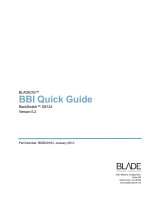
BLADEOS 6.5.2 Application Guide
18 Preface BMD00220, October 2010
Part 2: Securing the Switch
Chapter 3, “Securing Administration,” describes methods for using Secure Shell for
administration connections, and configuring end-user access control.
Chapter 4, “Authentication & Authorization Protocols,” describes different secure
administration for remote administrators. This includes using Remote Authentication Dial-in
User Service (RADIUS), as well as TACACS+ and LDAP.
Chapter 5, “Access Control Lists,” describes how to use filters to permit or deny specific types
of traffic, based on a variety of source, destination, and packet attributes.
Part 3: Switch Basics
Chapter 6, “VLANs,” describes how to configure Virtual Local Area Networks (VLANs) for
creating separate network segments, including how to use VLAN tagging for devices that use
multiple VLANs. This chapter also describes Protocol-based VLANs, and Private VLANs.
Chapter 7, “Ports and Trunking,” describes how to group multiple physical ports together to
aggregate the bandwidth between large-scale network devices.
Chapter 8, “Spanning Tree Protocols,” discusses how Spanning Tree Protocol (STP) configures
the network so that the switch selects the most efficient path when multiple paths exist. Also
includes the Rapid Spanning Tree Protocol (RSTP), Per-VLAN Rapid Spanning Tree Plus
(PVRST+), and Multiple Spanning Tree Protocol (MSTP) extensions to STP.
Chapter 9, “Quality of Service,” discusses Quality of Service (QoS) features, including IP
filtering using Access Control Lists (ACLs), Differentiated Services, and IEEE 802.1p priority
values.
Part 4: Advanced Switching Features
Chapter 10, “Deployment Profiles,” describes how the G8124 can operate in different modes
for different deployment scenarios, adjusting switch capacity levels in order to optimize
performance for different types of networks.
Chapter 11, “Virtualization,” provides an overview of allocating resources based on the logical
needs of the data center, rather than on the strict, physical nature of components.
Chapter 12, “Virtual NICs,” discusses using virtual NIC (vNIC) technology to divide NICs into
multiple logical, independent instances.
Chapter 13, “VMready,” discusses virtual machine (VM) support on the G8124.
Chapter 14, “FCoE and CEE,” discusses using various Converged Enhanced Ethernet (CEE)
features such as Priority-based Flow Control (PFC), Enhanced Transmission Selection (ETS),
and FIP Snooping for solutions such as Fibre Channel over Ethernet (FCoE).























